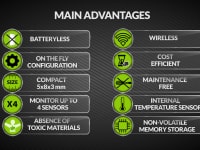
1) Challenge of change
Wireless sensors are the troops of the IOT, the on-the-ground pieces of hardware doing the critical task of monitoring processes, taking measurements and collecting data.
Today, battery-powered wireless devices are very popular. However, there are challenges:
• Many fields of research focus on achieving better miniaturization of sensors and electronics. However, Moore’s law does not apply to batteries; they are the largest component of the design;
• Batteries last for only a limited time and must, therefore, be replaced regularly;
• At the end of their lifetime, they are hazardous waste due to the toxicity of materials.
• Lithium is volatile and can catch fire;
• Strict regulations limit their use in many applications due to their toxicity.
2) Our design
We believe that RF Energy harvesting technology is the best option to make devices that can wirelessly communicate without the need for cables or batteries. Smartphones and smart watches are already using this technology in some applications such as contactless payment and tag identification. We designed a highly integrated wireless and battery-less frontend platform (hardware and software) that can monitor up to four sensors simultaneously.
Our design is based on two perfectly tuned coil antennae used for the wireless transfer of power and data; the power required to operate our device is wirelessly transferred from the reader antenna to our transponder’s antenna using electromagnetic resonance. Our wireless communication protocol is based on a known modulation and demodulation technique which is compliant to the ISO15693 standard.
As a proof of concept, we used a near field reader connected to a computer to wirelessly transfer power to our device and read data from it. Next step we will develop an app to use smartphones as readers.
3) Combined benefits
Our wireless and batteryless monitoring unit offers many competitive advantages:
• Being independent of an energy source like batteries or cables, our device can be flexibly placed and is maintenance free;
• RF Energy harvesting technology prevents battery waste and brings the clean-tech aspect to consumer devices;
• Easy and ready to use;
• Can monitor up to 4 sensors simultaneously;
• A standard communication protocol, compatible with the majority of smartphones;
• Our device can be easily manufactured using batch fabrication technique at a very low cost;
• Very compact (5x8x3 mm);
• Programmable ID;
• On the fly configuration and Non-volatile memory storage;
4) Marketability
Size and power are the major challenges of an Internet of Things where Trillions of wireless sensors are expected to deliver the needed data. A total of 6 Trillion US$ will be spent between 2015 and 2020. Due to biocompatibility, infections and size concerns, the need for wireless and battery-less systems is evident especially for connected health and wearables (Market share 26%). From a practical, environmental and reliability standpoint, it is also the perfect match for smart utilities and consumer devices (Market share 14%).
For those reasons we are convinced that our design is a technology with a future.
Video
-
Awards
-
 2018 Top 100 Entries
2018 Top 100 Entries
Like this entry?
-
About the Entrant
- Name:Houssem Eddine Amor
- Type of entry:teamTeam members:Houssem Eddine Amor
Wael Amor
Faten Ben Hmida - Software used for this entry:Altium
- Patent status:none








